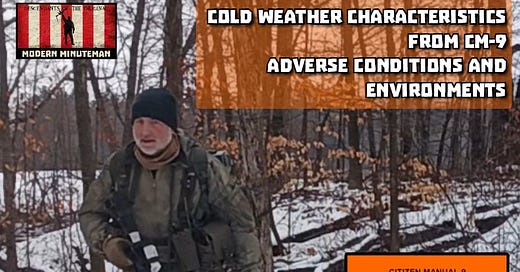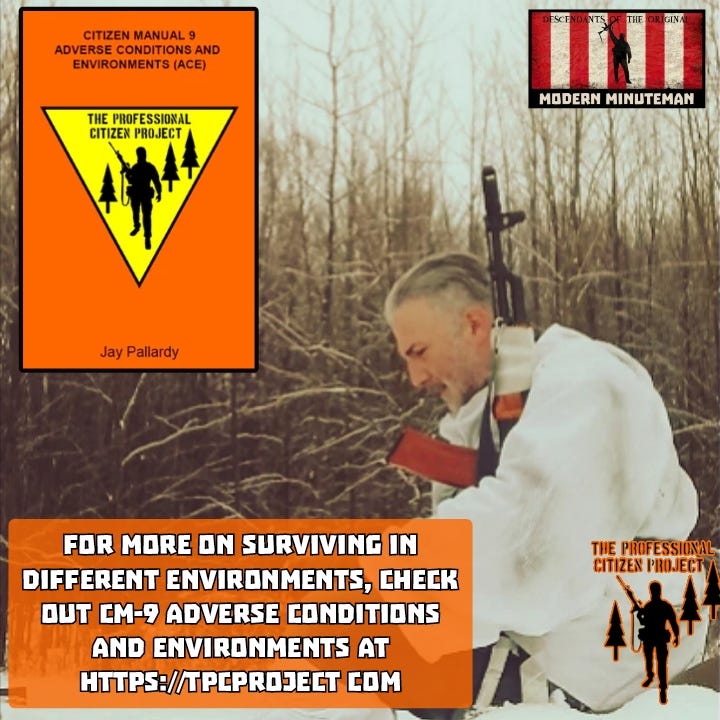Book excerpt from CM-9 Adverse Conditions and Environments from The Professional Citizen Project
Cold weather conditions can cause numerous problems for the Professional Citizen and Modern Minuteman. Understanding how cold weather can affect you can help you to better understand how to plan, operate, and survive in it.
COLD WEATHER CHARACTERISTICS
Cold weather conditions can be classified using categories. The temperature categories are:
Wet cold, +39° F to +20° F (4° C to -7° C)
Dry cold, +19° F to -4° F (-7° C to -20° C)
Intense cold, -5° F to -2° F (-20° C to -32° C)
Extreme cold, -25° F to -40° F (-32° C to -40° C)
Hazardous cold, -40° F (-40° C) and below
-Wet cold conditions occur when wet snow and rain often accompany wet cold conditions. This type of environment is more dangerous to folks and equipment than the colder, dry cold environments because the ground becomes slushy and muddy and clothing and equipment becomes perpetually wet and damp. Because water conducts heat 25 times faster than air, core body temperatures drop if folks are wet and the wind is blowing. The Professional Citizen can become a casualty due to weather if not properly equipped, trained, and led. Wet cold environments combined with wind is dangerous because of the wind’s effect on the body’s perceived temperature. Wet cold leads to hypothermia, frost bite, and trench foot. Wet cold conditions are not only found in mountain environments but in many other environments during seasonal transition periods. Under wet cold conditions, the ground alternates between freezing and thawing because the temperatures fluctuate above and below the freezing point. This makes planning problematic. For example, areas that are trafficable when frozen could become severely restricted if the ground thaws.
-Dry cold conditions are easier to live in than wet cold conditions. Like in wet cold conditions, proper equipment, training, and leadership are critical to successful operations. Wind chill is a complicated factor in this type of cold. The dry cold environment is the easiest of the four cold weather categories to survive in because of low humidity and the ground remaining frozen. As a result, people and equipment are not subject to the effects of the thawing and freezing cycle, and precipitation is generally in the form of dry snow.
-Intense cold conditions can affect the mind as much as the body. Simple tasks take longer and require more effort than in warmer temperatures and the quality of work degrades as attention-to-detail diminishes. Clothing becomes bulkier to compensate for the cold, so folks lose dexterity.
-Extreme cold conditions increase the challenge of survival becomes paramount. During extreme cold conditions, it is easy for folks to prioritize physical comfort above all else.
People will withdraw into themselves and adopt a cocoon-like existence. Leaders must expect and plan for weapons, vehicles, and munitions failures in this environment. As in other categories, leadership, training and specialized equipment is critical to the ability to operate successfully.
-In hazardous cold conditions, leaders and planners assume greater risk if they engage in operations when the temperature falls below -40° F (-40° C). Groups must be extensively trained before undertaking any field exercise or outing in these temperature extremes.
For more on surviving in different environments, check out CM-9 Surviving Adverse Conditions and Environments from The Professional Citizen Project.
The Professional Citizen Project manuals include:
CM-1 Individual Tactical Skills
CM-2 Reconnaissance
CM-3 AR Pattern Rifle and Carbine
CM-4 Land Navigation
CM-5 Teenage Prepper
CM-8 The Modern Minuteman
CM-9 Adverse Conditions and Environments (ACE)





